PROJ6006: Case Study on Project Management and Leadership in EWS
VerifiedAdded on 2023/05/29
|10
|2488
|158
Case Study
AI Summary
This assignment presents a case study analysis of Ecological Wastewater Solutions (EWS) and its project management strategies. The student identifies pacesetting and democratic leadership styles as appropriate for the project, highlighting their benefits in assigning duties and leveraging expert opinions. The analysis discusses tools and techniques such as Crawford slip adaptation and success-failure techniques. It also addresses communication strategies, emphasizing the use of a secure project portal and face-to-face meetings. The study explores the use of reward power for motivating the project team. The analysis then details methods for evaluating self-managed teams, including character-based evaluations and assessments of trust, transparency, honesty, and leadership skills. The student also identifies challenges such as communication barriers and geographically dispersed teams, proposing solutions like determining communication flows, implementing collaboration software, and utilizing centralized project management software. The case study provides a comprehensive overview of project management challenges and potential solutions within the context of EWS's expansion.
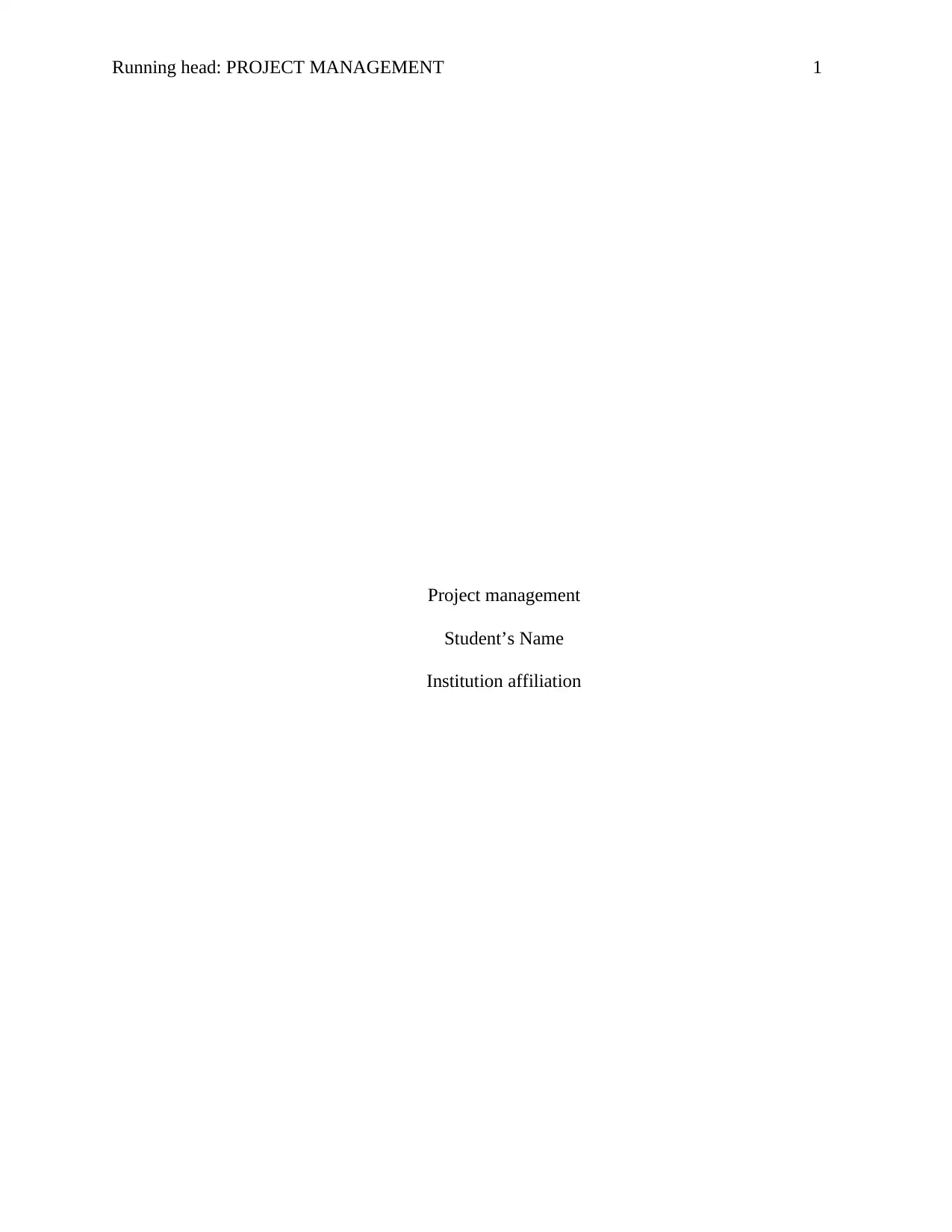
Running head: PROJECT MANAGEMENT 1
Project management
Student’s Name
Institution affiliation
Project management
Student’s Name
Institution affiliation
Paraphrase This Document
Need a fresh take? Get an instant paraphrase of this document with our AI Paraphraser
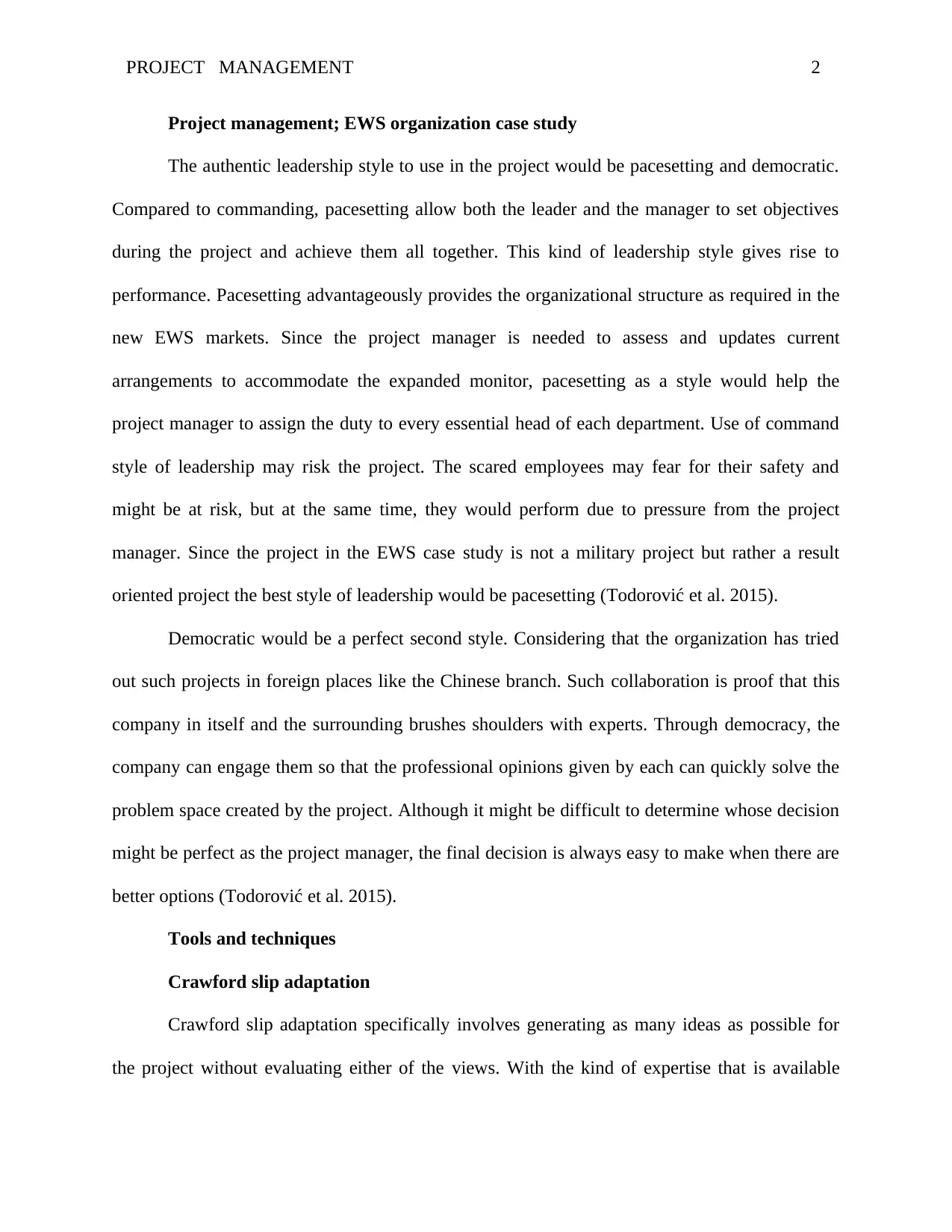
PROJECT MANAGEMENT 2
Project management; EWS organization case study
The authentic leadership style to use in the project would be pacesetting and democratic.
Compared to commanding, pacesetting allow both the leader and the manager to set objectives
during the project and achieve them all together. This kind of leadership style gives rise to
performance. Pacesetting advantageously provides the organizational structure as required in the
new EWS markets. Since the project manager is needed to assess and updates current
arrangements to accommodate the expanded monitor, pacesetting as a style would help the
project manager to assign the duty to every essential head of each department. Use of command
style of leadership may risk the project. The scared employees may fear for their safety and
might be at risk, but at the same time, they would perform due to pressure from the project
manager. Since the project in the EWS case study is not a military project but rather a result
oriented project the best style of leadership would be pacesetting (Todorović et al. 2015).
Democratic would be a perfect second style. Considering that the organization has tried
out such projects in foreign places like the Chinese branch. Such collaboration is proof that this
company in itself and the surrounding brushes shoulders with experts. Through democracy, the
company can engage them so that the professional opinions given by each can quickly solve the
problem space created by the project. Although it might be difficult to determine whose decision
might be perfect as the project manager, the final decision is always easy to make when there are
better options (Todorović et al. 2015).
Tools and techniques
Crawford slip adaptation
Crawford slip adaptation specifically involves generating as many ideas as possible for
the project without evaluating either of the views. With the kind of expertise that is available
Project management; EWS organization case study
The authentic leadership style to use in the project would be pacesetting and democratic.
Compared to commanding, pacesetting allow both the leader and the manager to set objectives
during the project and achieve them all together. This kind of leadership style gives rise to
performance. Pacesetting advantageously provides the organizational structure as required in the
new EWS markets. Since the project manager is needed to assess and updates current
arrangements to accommodate the expanded monitor, pacesetting as a style would help the
project manager to assign the duty to every essential head of each department. Use of command
style of leadership may risk the project. The scared employees may fear for their safety and
might be at risk, but at the same time, they would perform due to pressure from the project
manager. Since the project in the EWS case study is not a military project but rather a result
oriented project the best style of leadership would be pacesetting (Todorović et al. 2015).
Democratic would be a perfect second style. Considering that the organization has tried
out such projects in foreign places like the Chinese branch. Such collaboration is proof that this
company in itself and the surrounding brushes shoulders with experts. Through democracy, the
company can engage them so that the professional opinions given by each can quickly solve the
problem space created by the project. Although it might be difficult to determine whose decision
might be perfect as the project manager, the final decision is always easy to make when there are
better options (Todorović et al. 2015).
Tools and techniques
Crawford slip adaptation
Crawford slip adaptation specifically involves generating as many ideas as possible for
the project without evaluating either of the views. With the kind of expertise that is available
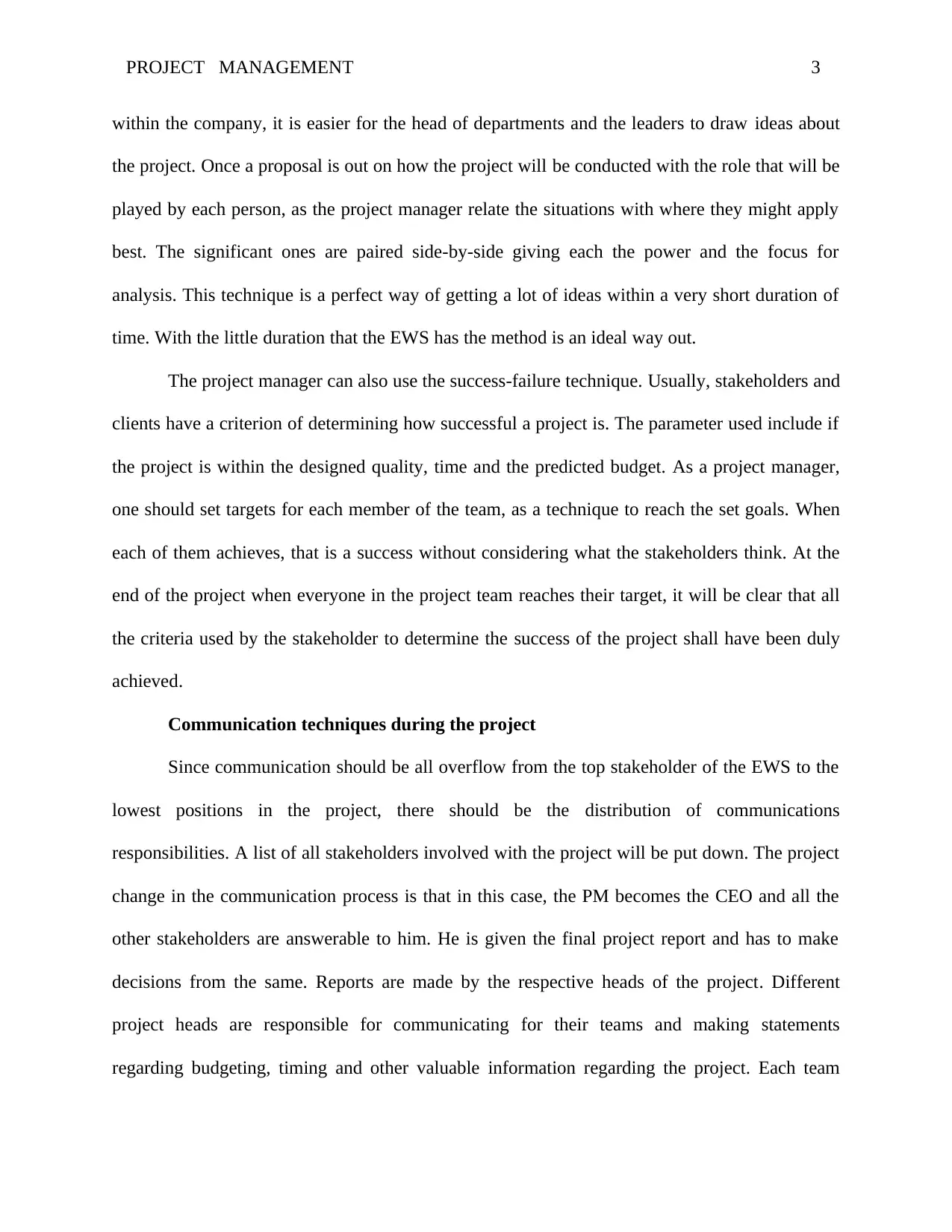
PROJECT MANAGEMENT 3
within the company, it is easier for the head of departments and the leaders to draw ideas about
the project. Once a proposal is out on how the project will be conducted with the role that will be
played by each person, as the project manager relate the situations with where they might apply
best. The significant ones are paired side-by-side giving each the power and the focus for
analysis. This technique is a perfect way of getting a lot of ideas within a very short duration of
time. With the little duration that the EWS has the method is an ideal way out.
The project manager can also use the success-failure technique. Usually, stakeholders and
clients have a criterion of determining how successful a project is. The parameter used include if
the project is within the designed quality, time and the predicted budget. As a project manager,
one should set targets for each member of the team, as a technique to reach the set goals. When
each of them achieves, that is a success without considering what the stakeholders think. At the
end of the project when everyone in the project team reaches their target, it will be clear that all
the criteria used by the stakeholder to determine the success of the project shall have been duly
achieved.
Communication techniques during the project
Since communication should be all overflow from the top stakeholder of the EWS to the
lowest positions in the project, there should be the distribution of communications
responsibilities. A list of all stakeholders involved with the project will be put down. The project
change in the communication process is that in this case, the PM becomes the CEO and all the
other stakeholders are answerable to him. He is given the final project report and has to make
decisions from the same. Reports are made by the respective heads of the project. Different
project heads are responsible for communicating for their teams and making statements
regarding budgeting, timing and other valuable information regarding the project. Each team
within the company, it is easier for the head of departments and the leaders to draw ideas about
the project. Once a proposal is out on how the project will be conducted with the role that will be
played by each person, as the project manager relate the situations with where they might apply
best. The significant ones are paired side-by-side giving each the power and the focus for
analysis. This technique is a perfect way of getting a lot of ideas within a very short duration of
time. With the little duration that the EWS has the method is an ideal way out.
The project manager can also use the success-failure technique. Usually, stakeholders and
clients have a criterion of determining how successful a project is. The parameter used include if
the project is within the designed quality, time and the predicted budget. As a project manager,
one should set targets for each member of the team, as a technique to reach the set goals. When
each of them achieves, that is a success without considering what the stakeholders think. At the
end of the project when everyone in the project team reaches their target, it will be clear that all
the criteria used by the stakeholder to determine the success of the project shall have been duly
achieved.
Communication techniques during the project
Since communication should be all overflow from the top stakeholder of the EWS to the
lowest positions in the project, there should be the distribution of communications
responsibilities. A list of all stakeholders involved with the project will be put down. The project
change in the communication process is that in this case, the PM becomes the CEO and all the
other stakeholders are answerable to him. He is given the final project report and has to make
decisions from the same. Reports are made by the respective heads of the project. Different
project heads are responsible for communicating for their teams and making statements
regarding budgeting, timing and other valuable information regarding the project. Each team
⊘ This is a preview!⊘
Do you want full access?
Subscribe today to unlock all pages.

Trusted by 1+ million students worldwide
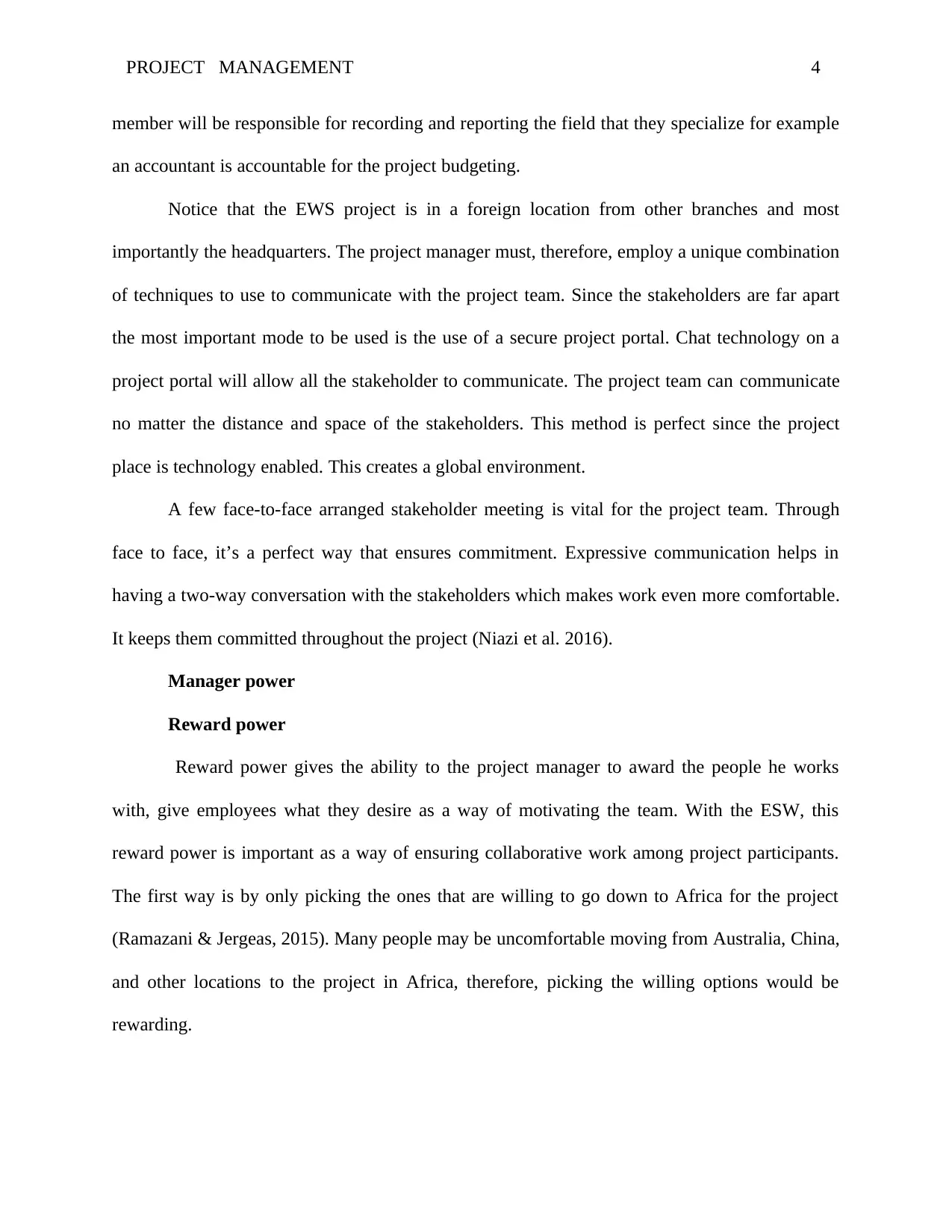
PROJECT MANAGEMENT 4
member will be responsible for recording and reporting the field that they specialize for example
an accountant is accountable for the project budgeting.
Notice that the EWS project is in a foreign location from other branches and most
importantly the headquarters. The project manager must, therefore, employ a unique combination
of techniques to use to communicate with the project team. Since the stakeholders are far apart
the most important mode to be used is the use of a secure project portal. Chat technology on a
project portal will allow all the stakeholder to communicate. The project team can communicate
no matter the distance and space of the stakeholders. This method is perfect since the project
place is technology enabled. This creates a global environment.
A few face-to-face arranged stakeholder meeting is vital for the project team. Through
face to face, it’s a perfect way that ensures commitment. Expressive communication helps in
having a two-way conversation with the stakeholders which makes work even more comfortable.
It keeps them committed throughout the project (Niazi et al. 2016).
Manager power
Reward power
Reward power gives the ability to the project manager to award the people he works
with, give employees what they desire as a way of motivating the team. With the ESW, this
reward power is important as a way of ensuring collaborative work among project participants.
The first way is by only picking the ones that are willing to go down to Africa for the project
(Ramazani & Jergeas, 2015). Many people may be uncomfortable moving from Australia, China,
and other locations to the project in Africa, therefore, picking the willing options would be
rewarding.
member will be responsible for recording and reporting the field that they specialize for example
an accountant is accountable for the project budgeting.
Notice that the EWS project is in a foreign location from other branches and most
importantly the headquarters. The project manager must, therefore, employ a unique combination
of techniques to use to communicate with the project team. Since the stakeholders are far apart
the most important mode to be used is the use of a secure project portal. Chat technology on a
project portal will allow all the stakeholder to communicate. The project team can communicate
no matter the distance and space of the stakeholders. This method is perfect since the project
place is technology enabled. This creates a global environment.
A few face-to-face arranged stakeholder meeting is vital for the project team. Through
face to face, it’s a perfect way that ensures commitment. Expressive communication helps in
having a two-way conversation with the stakeholders which makes work even more comfortable.
It keeps them committed throughout the project (Niazi et al. 2016).
Manager power
Reward power
Reward power gives the ability to the project manager to award the people he works
with, give employees what they desire as a way of motivating the team. With the ESW, this
reward power is important as a way of ensuring collaborative work among project participants.
The first way is by only picking the ones that are willing to go down to Africa for the project
(Ramazani & Jergeas, 2015). Many people may be uncomfortable moving from Australia, China,
and other locations to the project in Africa, therefore, picking the willing options would be
rewarding.
Paraphrase This Document
Need a fresh take? Get an instant paraphrase of this document with our AI Paraphraser
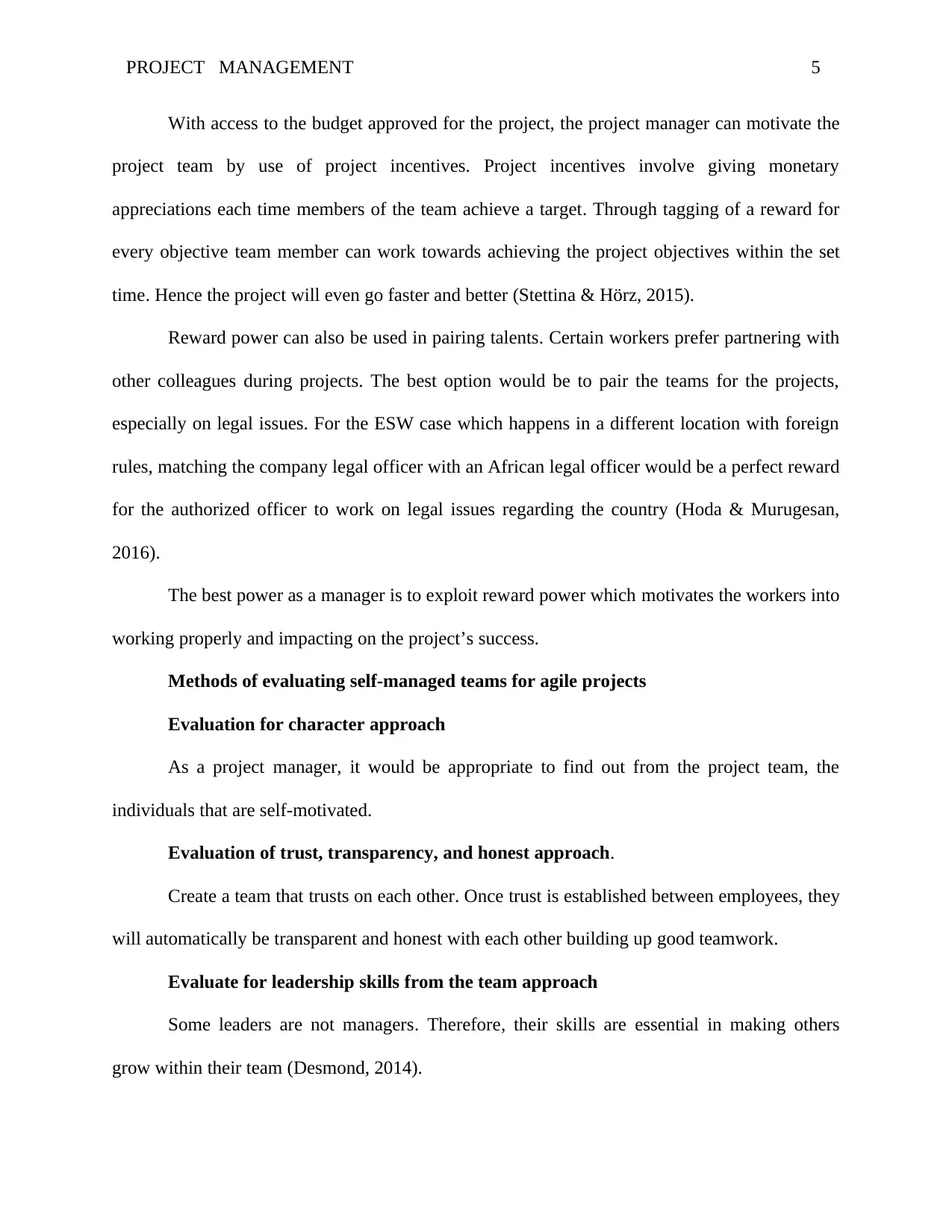
PROJECT MANAGEMENT 5
With access to the budget approved for the project, the project manager can motivate the
project team by use of project incentives. Project incentives involve giving monetary
appreciations each time members of the team achieve a target. Through tagging of a reward for
every objective team member can work towards achieving the project objectives within the set
time. Hence the project will even go faster and better (Stettina & Hörz, 2015).
Reward power can also be used in pairing talents. Certain workers prefer partnering with
other colleagues during projects. The best option would be to pair the teams for the projects,
especially on legal issues. For the ESW case which happens in a different location with foreign
rules, matching the company legal officer with an African legal officer would be a perfect reward
for the authorized officer to work on legal issues regarding the country (Hoda & Murugesan,
2016).
The best power as a manager is to exploit reward power which motivates the workers into
working properly and impacting on the project’s success.
Methods of evaluating self-managed teams for agile projects
Evaluation for character approach
As a project manager, it would be appropriate to find out from the project team, the
individuals that are self-motivated.
Evaluation of trust, transparency, and honest approach.
Create a team that trusts on each other. Once trust is established between employees, they
will automatically be transparent and honest with each other building up good teamwork.
Evaluate for leadership skills from the team approach
Some leaders are not managers. Therefore, their skills are essential in making others
grow within their team (Desmond, 2014).
With access to the budget approved for the project, the project manager can motivate the
project team by use of project incentives. Project incentives involve giving monetary
appreciations each time members of the team achieve a target. Through tagging of a reward for
every objective team member can work towards achieving the project objectives within the set
time. Hence the project will even go faster and better (Stettina & Hörz, 2015).
Reward power can also be used in pairing talents. Certain workers prefer partnering with
other colleagues during projects. The best option would be to pair the teams for the projects,
especially on legal issues. For the ESW case which happens in a different location with foreign
rules, matching the company legal officer with an African legal officer would be a perfect reward
for the authorized officer to work on legal issues regarding the country (Hoda & Murugesan,
2016).
The best power as a manager is to exploit reward power which motivates the workers into
working properly and impacting on the project’s success.
Methods of evaluating self-managed teams for agile projects
Evaluation for character approach
As a project manager, it would be appropriate to find out from the project team, the
individuals that are self-motivated.
Evaluation of trust, transparency, and honest approach.
Create a team that trusts on each other. Once trust is established between employees, they
will automatically be transparent and honest with each other building up good teamwork.
Evaluate for leadership skills from the team approach
Some leaders are not managers. Therefore, their skills are essential in making others
grow within their team (Desmond, 2014).
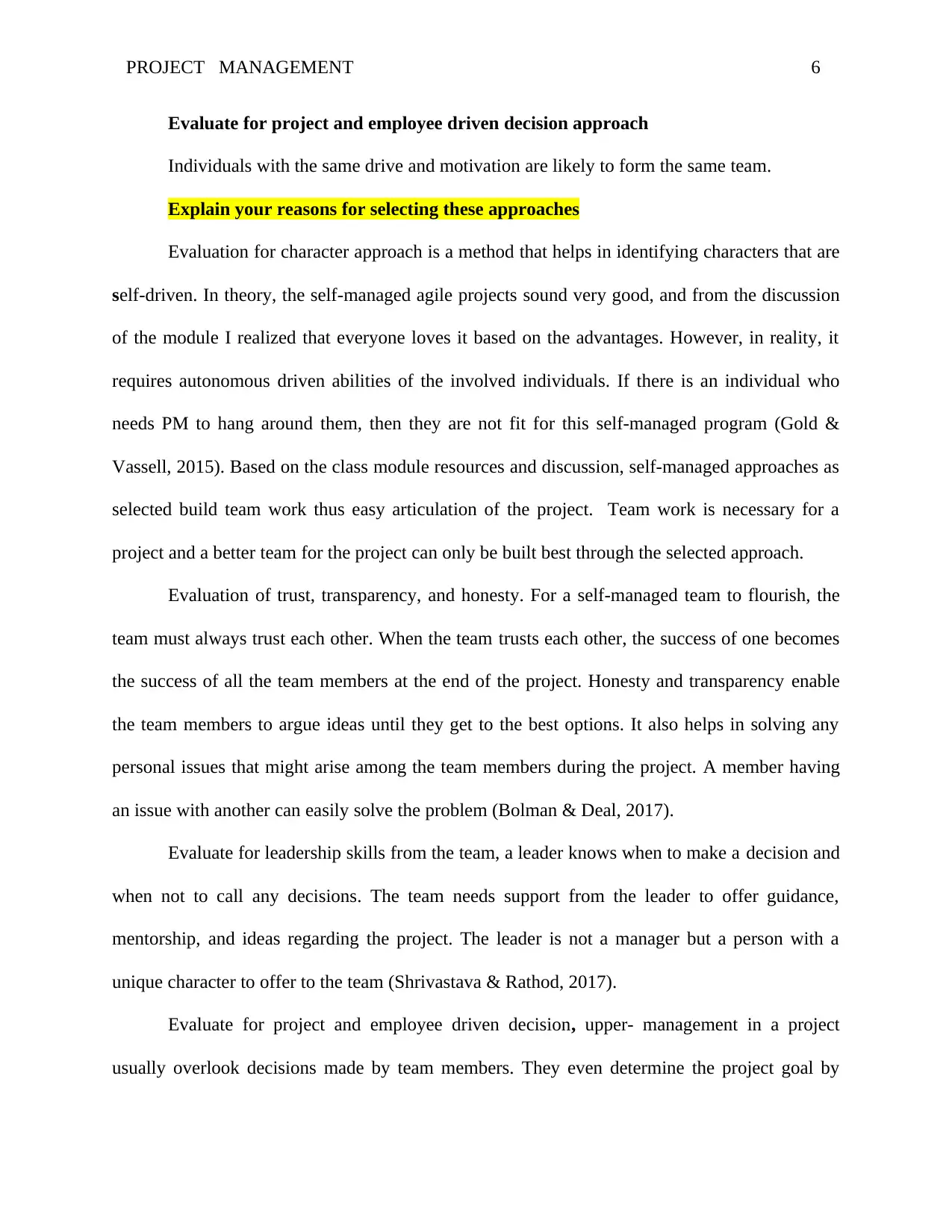
PROJECT MANAGEMENT 6
Evaluate for project and employee driven decision approach
Individuals with the same drive and motivation are likely to form the same team.
Explain your reasons for selecting these approaches
Evaluation for character approach is a method that helps in identifying characters that are
self-driven. In theory, the self-managed agile projects sound very good, and from the discussion
of the module I realized that everyone loves it based on the advantages. However, in reality, it
requires autonomous driven abilities of the involved individuals. If there is an individual who
needs PM to hang around them, then they are not fit for this self-managed program (Gold &
Vassell, 2015). Based on the class module resources and discussion, self-managed approaches as
selected build team work thus easy articulation of the project. Team work is necessary for a
project and a better team for the project can only be built best through the selected approach.
Evaluation of trust, transparency, and honesty. For a self-managed team to flourish, the
team must always trust each other. When the team trusts each other, the success of one becomes
the success of all the team members at the end of the project. Honesty and transparency enable
the team members to argue ideas until they get to the best options. It also helps in solving any
personal issues that might arise among the team members during the project. A member having
an issue with another can easily solve the problem (Bolman & Deal, 2017).
Evaluate for leadership skills from the team, a leader knows when to make a decision and
when not to call any decisions. The team needs support from the leader to offer guidance,
mentorship, and ideas regarding the project. The leader is not a manager but a person with a
unique character to offer to the team (Shrivastava & Rathod, 2017).
Evaluate for project and employee driven decision, upper- management in a project
usually overlook decisions made by team members. They even determine the project goal by
Evaluate for project and employee driven decision approach
Individuals with the same drive and motivation are likely to form the same team.
Explain your reasons for selecting these approaches
Evaluation for character approach is a method that helps in identifying characters that are
self-driven. In theory, the self-managed agile projects sound very good, and from the discussion
of the module I realized that everyone loves it based on the advantages. However, in reality, it
requires autonomous driven abilities of the involved individuals. If there is an individual who
needs PM to hang around them, then they are not fit for this self-managed program (Gold &
Vassell, 2015). Based on the class module resources and discussion, self-managed approaches as
selected build team work thus easy articulation of the project. Team work is necessary for a
project and a better team for the project can only be built best through the selected approach.
Evaluation of trust, transparency, and honesty. For a self-managed team to flourish, the
team must always trust each other. When the team trusts each other, the success of one becomes
the success of all the team members at the end of the project. Honesty and transparency enable
the team members to argue ideas until they get to the best options. It also helps in solving any
personal issues that might arise among the team members during the project. A member having
an issue with another can easily solve the problem (Bolman & Deal, 2017).
Evaluate for leadership skills from the team, a leader knows when to make a decision and
when not to call any decisions. The team needs support from the leader to offer guidance,
mentorship, and ideas regarding the project. The leader is not a manager but a person with a
unique character to offer to the team (Shrivastava & Rathod, 2017).
Evaluate for project and employee driven decision, upper- management in a project
usually overlook decisions made by team members. They even determine the project goal by
⊘ This is a preview!⊘
Do you want full access?
Subscribe today to unlock all pages.

Trusted by 1+ million students worldwide
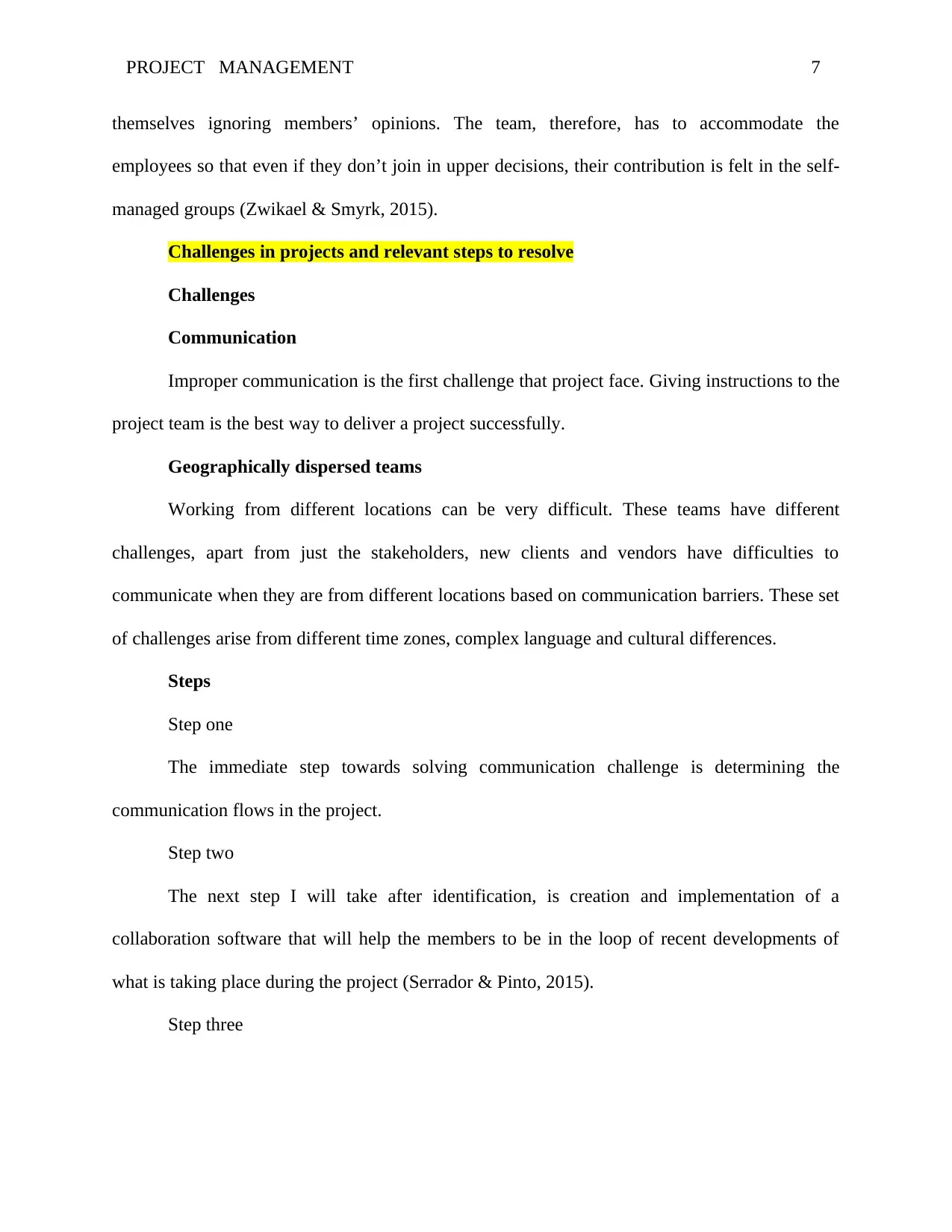
PROJECT MANAGEMENT 7
themselves ignoring members’ opinions. The team, therefore, has to accommodate the
employees so that even if they don’t join in upper decisions, their contribution is felt in the self-
managed groups (Zwikael & Smyrk, 2015).
Challenges in projects and relevant steps to resolve
Challenges
Communication
Improper communication is the first challenge that project face. Giving instructions to the
project team is the best way to deliver a project successfully.
Geographically dispersed teams
Working from different locations can be very difficult. These teams have different
challenges, apart from just the stakeholders, new clients and vendors have difficulties to
communicate when they are from different locations based on communication barriers. These set
of challenges arise from different time zones, complex language and cultural differences.
Steps
Step one
The immediate step towards solving communication challenge is determining the
communication flows in the project.
Step two
The next step I will take after identification, is creation and implementation of a
collaboration software that will help the members to be in the loop of recent developments of
what is taking place during the project (Serrador & Pinto, 2015).
Step three
themselves ignoring members’ opinions. The team, therefore, has to accommodate the
employees so that even if they don’t join in upper decisions, their contribution is felt in the self-
managed groups (Zwikael & Smyrk, 2015).
Challenges in projects and relevant steps to resolve
Challenges
Communication
Improper communication is the first challenge that project face. Giving instructions to the
project team is the best way to deliver a project successfully.
Geographically dispersed teams
Working from different locations can be very difficult. These teams have different
challenges, apart from just the stakeholders, new clients and vendors have difficulties to
communicate when they are from different locations based on communication barriers. These set
of challenges arise from different time zones, complex language and cultural differences.
Steps
Step one
The immediate step towards solving communication challenge is determining the
communication flows in the project.
Step two
The next step I will take after identification, is creation and implementation of a
collaboration software that will help the members to be in the loop of recent developments of
what is taking place during the project (Serrador & Pinto, 2015).
Step three
Paraphrase This Document
Need a fresh take? Get an instant paraphrase of this document with our AI Paraphraser
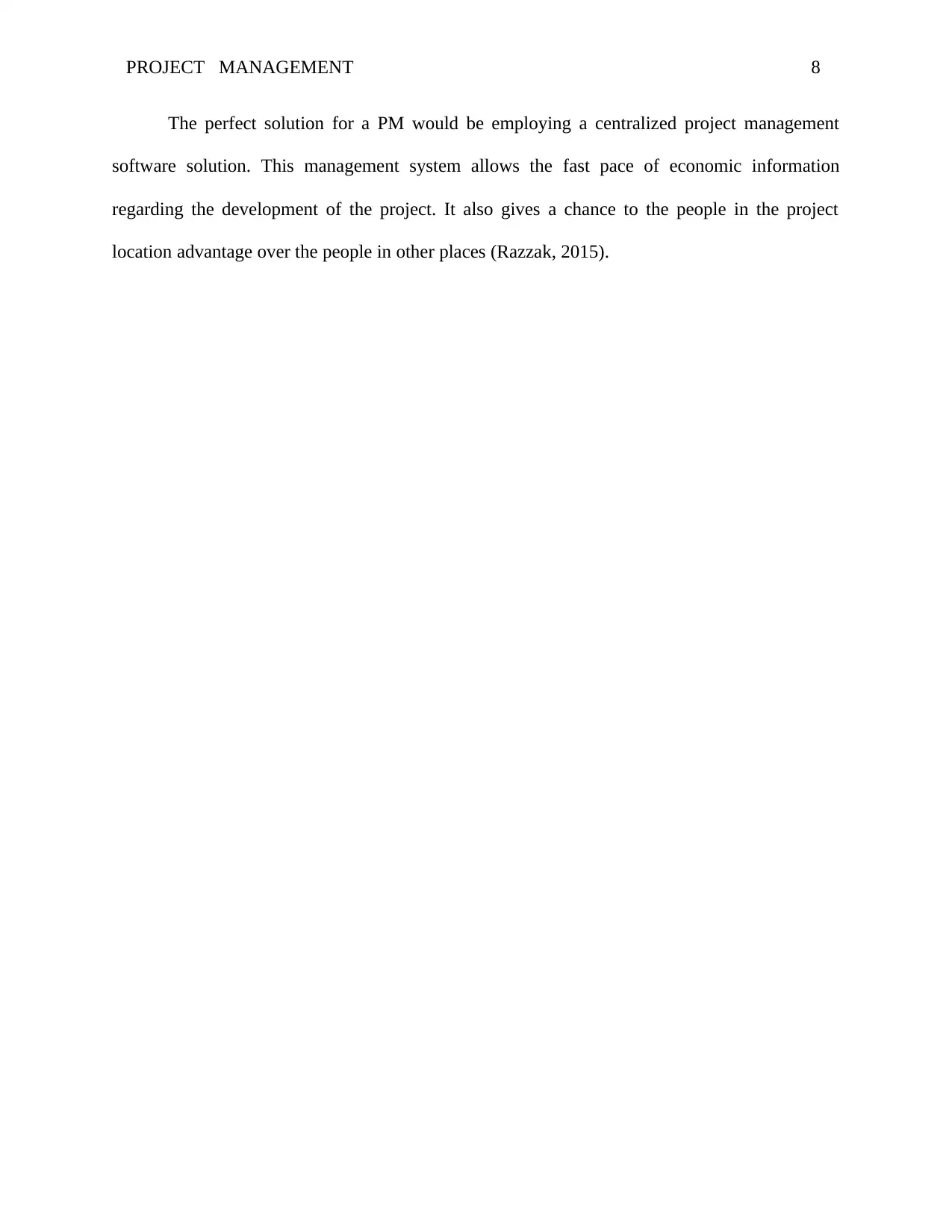
PROJECT MANAGEMENT 8
The perfect solution for a PM would be employing a centralized project management
software solution. This management system allows the fast pace of economic information
regarding the development of the project. It also gives a chance to the people in the project
location advantage over the people in other places (Razzak, 2015).
The perfect solution for a PM would be employing a centralized project management
software solution. This management system allows the fast pace of economic information
regarding the development of the project. It also gives a chance to the people in the project
location advantage over the people in other places (Razzak, 2015).
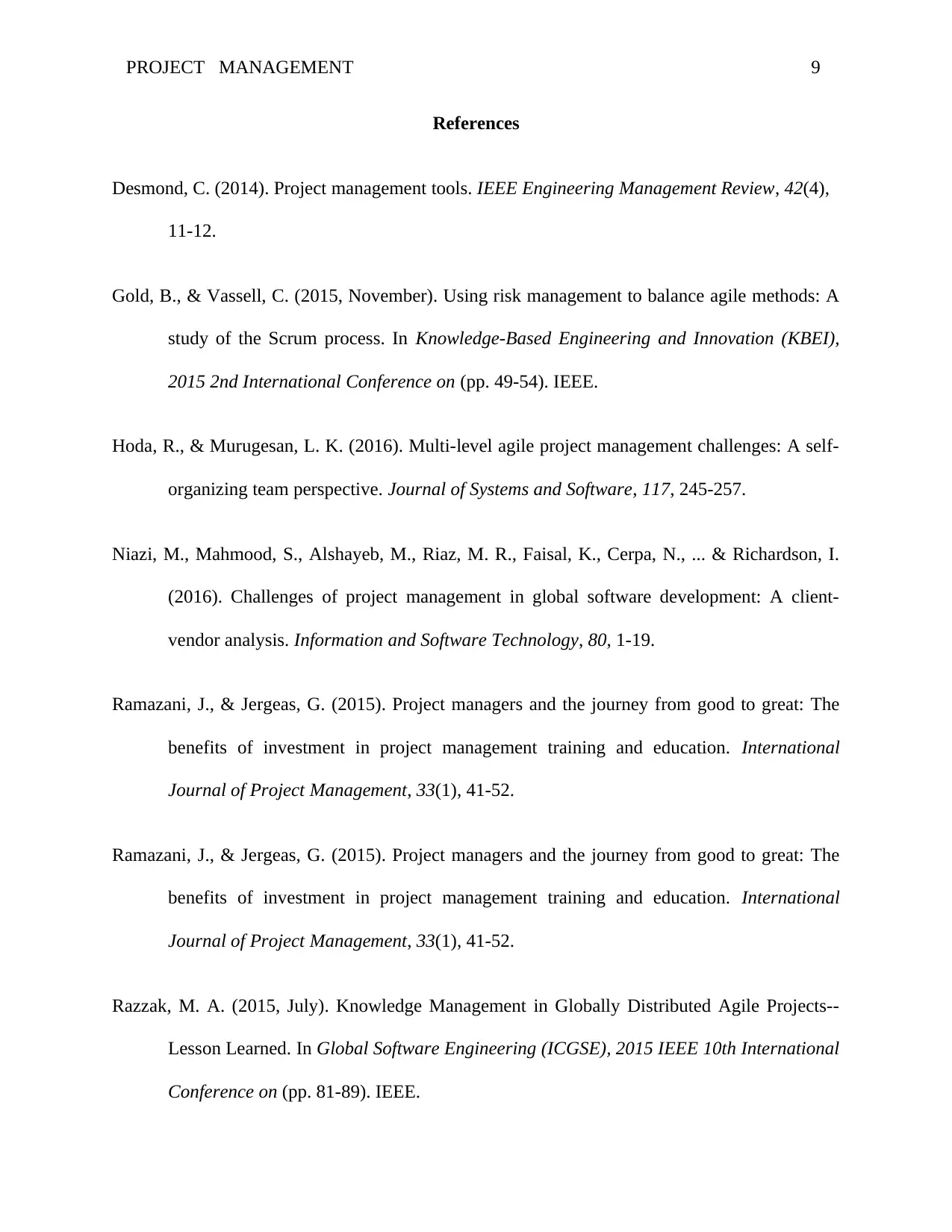
PROJECT MANAGEMENT 9
References
Desmond, C. (2014). Project management tools. IEEE Engineering Management Review, 42(4),
11-12.
Gold, B., & Vassell, C. (2015, November). Using risk management to balance agile methods: A
study of the Scrum process. In Knowledge-Based Engineering and Innovation (KBEI),
2015 2nd International Conference on (pp. 49-54). IEEE.
Hoda, R., & Murugesan, L. K. (2016). Multi-level agile project management challenges: A self-
organizing team perspective. Journal of Systems and Software, 117, 245-257.
Niazi, M., Mahmood, S., Alshayeb, M., Riaz, M. R., Faisal, K., Cerpa, N., ... & Richardson, I.
(2016). Challenges of project management in global software development: A client-
vendor analysis. Information and Software Technology, 80, 1-19.
Ramazani, J., & Jergeas, G. (2015). Project managers and the journey from good to great: The
benefits of investment in project management training and education. International
Journal of Project Management, 33(1), 41-52.
Ramazani, J., & Jergeas, G. (2015). Project managers and the journey from good to great: The
benefits of investment in project management training and education. International
Journal of Project Management, 33(1), 41-52.
Razzak, M. A. (2015, July). Knowledge Management in Globally Distributed Agile Projects--
Lesson Learned. In Global Software Engineering (ICGSE), 2015 IEEE 10th International
Conference on (pp. 81-89). IEEE.
References
Desmond, C. (2014). Project management tools. IEEE Engineering Management Review, 42(4),
11-12.
Gold, B., & Vassell, C. (2015, November). Using risk management to balance agile methods: A
study of the Scrum process. In Knowledge-Based Engineering and Innovation (KBEI),
2015 2nd International Conference on (pp. 49-54). IEEE.
Hoda, R., & Murugesan, L. K. (2016). Multi-level agile project management challenges: A self-
organizing team perspective. Journal of Systems and Software, 117, 245-257.
Niazi, M., Mahmood, S., Alshayeb, M., Riaz, M. R., Faisal, K., Cerpa, N., ... & Richardson, I.
(2016). Challenges of project management in global software development: A client-
vendor analysis. Information and Software Technology, 80, 1-19.
Ramazani, J., & Jergeas, G. (2015). Project managers and the journey from good to great: The
benefits of investment in project management training and education. International
Journal of Project Management, 33(1), 41-52.
Ramazani, J., & Jergeas, G. (2015). Project managers and the journey from good to great: The
benefits of investment in project management training and education. International
Journal of Project Management, 33(1), 41-52.
Razzak, M. A. (2015, July). Knowledge Management in Globally Distributed Agile Projects--
Lesson Learned. In Global Software Engineering (ICGSE), 2015 IEEE 10th International
Conference on (pp. 81-89). IEEE.
⊘ This is a preview!⊘
Do you want full access?
Subscribe today to unlock all pages.

Trusted by 1+ million students worldwide
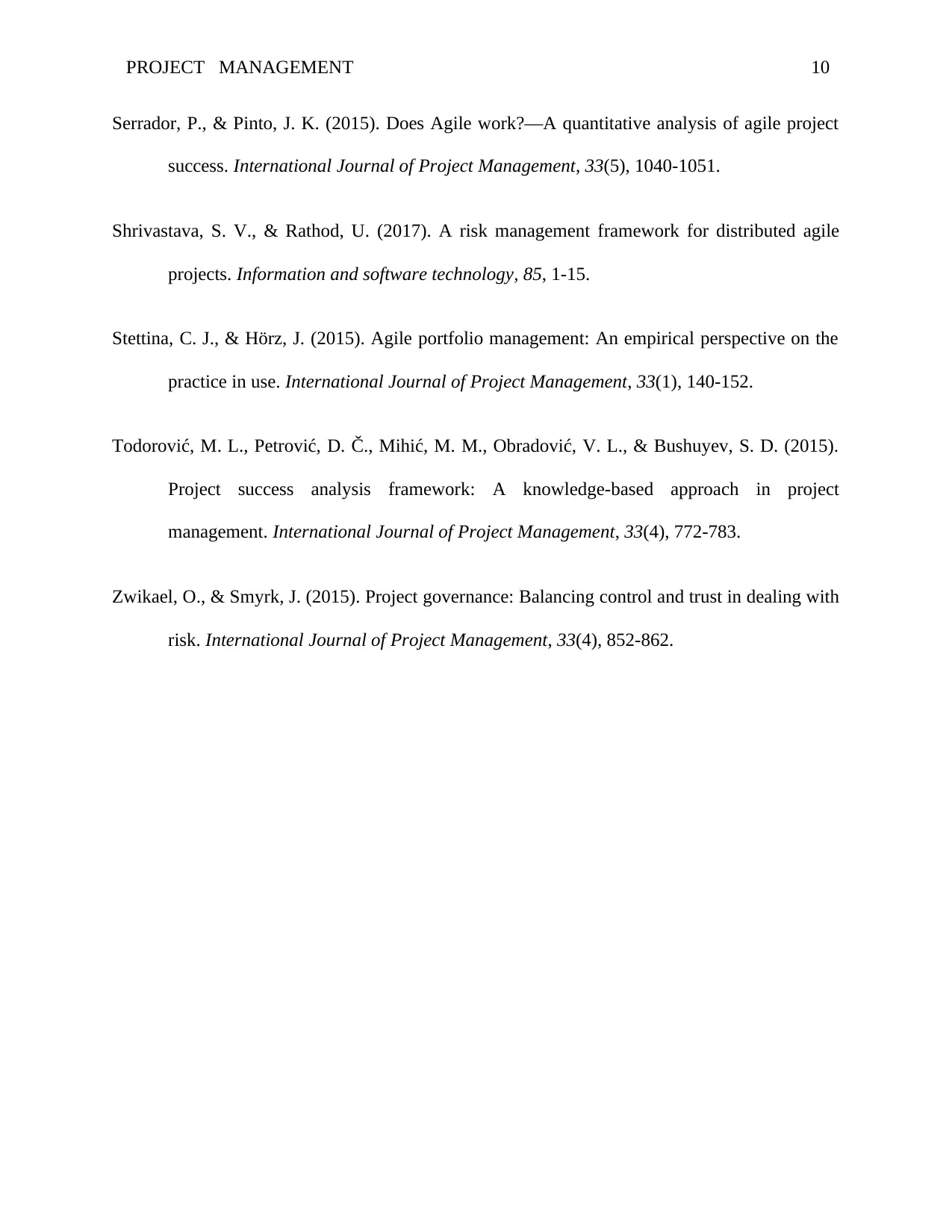
PROJECT MANAGEMENT 10
Serrador, P., & Pinto, J. K. (2015). Does Agile work?—A quantitative analysis of agile project
success. International Journal of Project Management, 33(5), 1040-1051.
Shrivastava, S. V., & Rathod, U. (2017). A risk management framework for distributed agile
projects. Information and software technology, 85, 1-15.
Stettina, C. J., & Hörz, J. (2015). Agile portfolio management: An empirical perspective on the
practice in use. International Journal of Project Management, 33(1), 140-152.
Todorović, M. L., Petrović, D. Č., Mihić, M. M., Obradović, V. L., & Bushuyev, S. D. (2015).
Project success analysis framework: A knowledge-based approach in project
management. International Journal of Project Management, 33(4), 772-783.
Zwikael, O., & Smyrk, J. (2015). Project governance: Balancing control and trust in dealing with
risk. International Journal of Project Management, 33(4), 852-862.
Serrador, P., & Pinto, J. K. (2015). Does Agile work?—A quantitative analysis of agile project
success. International Journal of Project Management, 33(5), 1040-1051.
Shrivastava, S. V., & Rathod, U. (2017). A risk management framework for distributed agile
projects. Information and software technology, 85, 1-15.
Stettina, C. J., & Hörz, J. (2015). Agile portfolio management: An empirical perspective on the
practice in use. International Journal of Project Management, 33(1), 140-152.
Todorović, M. L., Petrović, D. Č., Mihić, M. M., Obradović, V. L., & Bushuyev, S. D. (2015).
Project success analysis framework: A knowledge-based approach in project
management. International Journal of Project Management, 33(4), 772-783.
Zwikael, O., & Smyrk, J. (2015). Project governance: Balancing control and trust in dealing with
risk. International Journal of Project Management, 33(4), 852-862.
1 out of 10
Related Documents
Your All-in-One AI-Powered Toolkit for Academic Success.
+13062052269
info@desklib.com
Available 24*7 on WhatsApp / Email
![[object Object]](/_next/static/media/star-bottom.7253800d.svg)
Unlock your academic potential
Copyright © 2020–2025 A2Z Services. All Rights Reserved. Developed and managed by ZUCOL.





